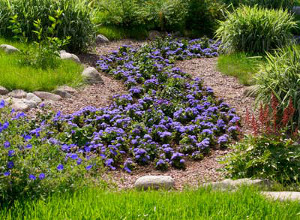
We love those seasonal rains, especially when they
come after such an intense drought. But if those showers
turn into gully-washers, they can cause problems for our
lakes and streams. Water that can’t be absorbed into our
lawns will run off into storm sewers, bringing along
excess fertilizer and other chemicals we put out to spruce
up our greenery.
The same goes for the rain that rolls off our driveways
and other paved surfaces, carrying a sheen of gas and oil
from our cars. Once they reach a lake or stream, these
chemicals can harm the local ecosystem, and the added
nutrients from fertilizer can encourage algae blooms that
may affect the taste of our water and cause other related
problems.
There is a way you can beautify your landscape, save water and help reduce pollution flowing into our lakes
and streams. The key is building a rain garden into your landscape to capture pollutants before they make
their way from our homes into the water cycle.

Rain gardens are made of layers of loose soil, gravel and mulch that hold
and filter the water of impurities as it is absorbed into the ground.
Landscapes can be designed around these gardens to make them more
effective. Best of all, the cost of building a basic rain garden is relatively
low, comparable with other landscaping projects. And with a rain garden,
you will be less likely to need to tap into public water supplies to maintain
the plants.
After establishing the filtering foundation, a rain garden is completed by
placing the plants that add color and detail to your yard while helping
disperse the water. A variety of plants on the surface will absorb excess water and release it back into the
atmosphere through transpiration.

While you have a lot of choices, native plants are highly recommended
since they are best suited to the climate, are typically low maintenance
and can be quite attractive. Some possibilities include black-eyed
Susans, sunflowers and pitcher sage.
Those concerned about excess water in the garden offering a breeding
ground for mosquitoes, need not worry. A properly designed rain garden
should only hold water a day or two, depending on rainfall amounts,
much too short a period for mosquitoes to complete their breeding
cycle.
Numerous Web sites are available that offer in-depth how-to guides on designing and building your rain
garden. You can find plentiful help here from the City of Austin and from the
Rain Garden Network, here.
Click here for tips from community gardens in Coppell, Texas.
When it comes to protecting our lakes and streams and conserving our precious water supply, every little effort
is a big help. Rain gardens offer each of us the chance to do just that, while spreading a little beauty.